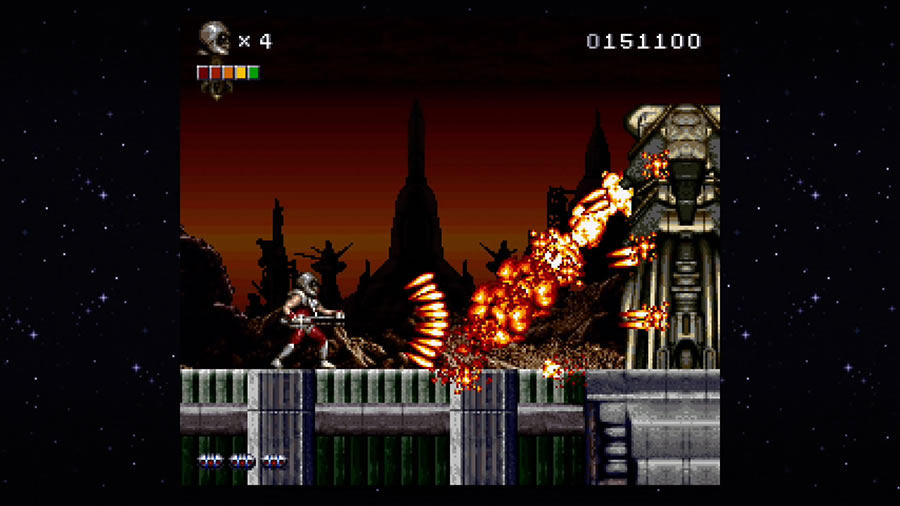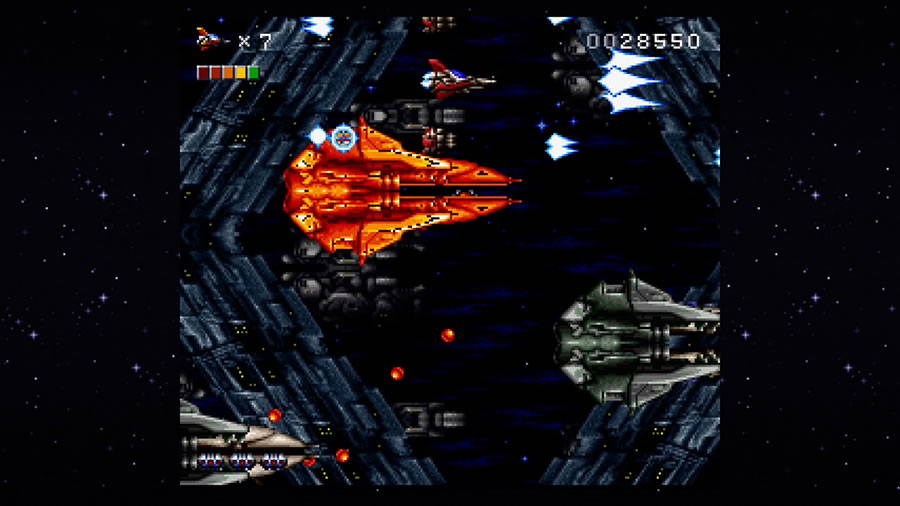- CLASSIC MAGAZINES
- REVIEW CREW
A show recapping what critics thought back
when classic games first came out! - NEXT GENERATION'S BEST & WORST
From the worst 1-star reviews to the best
5-stars can offer, this is Next Generation! - NINTENDO POWER (ARCHIVE)
Experience a variety of shows looking at the
often baffling history of Nintendo Power! - MAGAZINE RETROSPECTIVE
We're looking at the absolutely true history of
some of the most iconic game magazines ever! - SUPER PLAY'S TOP 600
The longest and most ambitious Super NES
countdown on the internet! - THEY SAID WHAT?
Debunking predictions and gossip found
in classic video game magazines! - NEXT GENERATION UNCOVERED
Cyril is back in this spin-off series, featuring the
cover critic review the art of Next Generation! - HARDCORE GAMER MAGAZING (PDF ISSUES)
Download all 36 issues of Hardcore Gamer
Magazine and relive the fun in PDF form!
- REVIEW CREW
- ELECTRONIC GAMING MONTHLY
- ELECTRONIC GAMING MONTHLY RANKS
From Mario to Sonic to Street Fighter, EGM
ranks classic game franchises and consoles! - ELECTRONIC GAMING MONTHLY BEST & WORST
Counting down EGM’s best and worst reviews
going year by year, from 1989 – 2009! - ELECTRONIC GAMING BEST & WORST AWARDS
11-part video series chronicling the ups and
downs of EGM’s Best & Worst Awards!
- ELECTRONIC GAMING MONTHLY RANKS
- GAME HISTORY
- GAME OVER: STORY BREAKDOWNS
Long-running series breaking down game
stories and analyzing their endings! - A BRIEF HISTORY OF GAMING w/ [NAME HERE]
Real history presented in a fun and pithy
format from a variety of game historians! - THE BLACK SHEEP
A series looking back at the black sheep
entries in popular game franchises! - INSTANT EXPERT
Everything you could possibly want to know
about a wide variety of gaming topics! - FREEZE FRAME
When something familiar happens in the games
industry, we're there to take a picture! - I'VE GOT YOUR NUMBER
Learn real video game history through a series
of number-themed episodes, starting at zero! - GREAT MOMENTS IN BAD ACTING
A joyous celebration of some of gaming's
absolute worst voice acting!
- GAME OVER: STORY BREAKDOWNS
- POPULAR SHOWS
- DG NEWS w/ LORNE RISELEY
Newsman Lorne Riseley hosts a regular
series looking at the hottest gaming news! - REVIEW REWIND
Cyril replays a game he reviewed 10+ years
ago to see if he got it right or wrong! - ON-RUNNING FEUDS
Defunct Games' longest-running show, with
editorials, observations and other fun oddities! - DEFUNCT GAMES QUIZ (ARCHIVE)
From online quizzes to game shows, we're
putting your video game knowledge to the test!- QUIZ: ONLINE PASS
Take a weekly quiz to see how well you know
the news and current gaming events! - QUIZ: KNOW THE GAME
One-on-one quiz show where contestants
find out if they actually know classic games! - QUIZ: THE LEADERBOARD
Can you guess the game based on the classic
review? Find out with The Leaderboard!
- QUIZ: ONLINE PASS
- DEFUNCT GAMES VS.
Cyril and the Defunct Games staff isn't afraid
to choose their favorite games and more! - CYRIL READS WORLDS OF POWER
Defunct Games recreates classic game
novelizations through the audio book format!
- DG NEWS w/ LORNE RISELEY
- COMEDY
- GAME EXPECTANCY
How long will your favorite hero live? We crunch
the numbers in this series about dying! - VIDEO GAME ADVICE
Famous game characters answer real personal
advice questions with a humorous slant! - FAKE GAMES: GUERILLA SCRAPBOOK
A long-running series about fake games and
the people who love them (covers included)! - WORST GAME EVER
A contest that attempts to create the worst
video game ever made, complete with covers! - LEVEL 1 STORIES
Literature based on the first stages of some
of your favorite classic video games! - THE COVER CRITIC
One of Defunct Games' earliest shows, Cover
Critic digs up some of the worst box art ever! - COMMERCIAL BREAK
Take a trip through some of the best and
worst video game advertisements of all time! - COMIC BOOK MODS
You've never seen comics like this before.
A curious mix of rewritten video game comics!
- GAME EXPECTANCY
- SERIES ARCHIVE
- NINTENDO SWITCH ONLINE ARCHIVE
A regularly-updated list of every Nintendo
Switch Online release, plus links to review! - PLAYSTATION PLUS CLASSIC ARCHIVE
A comprehensive list of every PlayStation
Plus classic release, including links! - RETRO-BIT PUBLISHING ARCHIVE
A regularly-updated list of every Retro-Bit
game released! - REVIEW MARATHONS w/ ADAM WALLACE
Join critic Adam Wallace as he takes us on a
classic review marathon with different themes!- DEFUNCT GAMES GOLF CLUB
Adam Wallace takes to the links to slice his way
through 72 classic golf game reviews! - 007 IN PIXELS
Adam Wallace takes on the world's greatest spy
as he reviews 15 weeks of James Bond games! - A SALUTE TO VAMPIRES
Adam Wallace is sinking his teeth into a series
covering Castlevania, BloodRayne and more! - CAPCOM'S CURSE
Adam Wallace is celebrating 13 days of Halloween
with a line-up of Capcom's scariest games! - THE FALL OF SUPERMAN
Adam Wallace is a man of steel for playing
some of the absolute worst Superman games! - THE 31 GAMES OF HALLOWEEN
Adam Wallace spends every day of October afraid
as he reviews some of the scariest games ever! - 12 WEEKS OF STAR TREK
Adam Wallace boldly goes where no critic has
gone before in this Star Trek marathon!
- DEFUNCT GAMES GOLF CLUB
- DAYS OF CHRISTMAS (ARCHIVE)
Annual holiday series with themed-episodes
that date all the way back to 2001!- 2015: 30 Ridiculous Retro Rumors
- 2014: 29 Magazines of Christmas
- 2013: 29 Questionable Power-Ups of Christmas
- 2012: 34 Theme Songs of Christmas
- 2011: 32 Game Endings of Christmas
- 2010: 31 Bonus Levels of Christmas
- 2009: 30 Genres of Christmas
- 2008: 29 Controls of Christmas
- 2007: 34 Cliches of Christmas
- 2006: 33 Consoles of Christmas
- 2005: 32 Articles of Christmas
- 2004: 31 Websites of Christmas
- 2003: 29 Issues of Christmas
- 2002: 28 Years of Christmas
- 2001: 33 Days of Christmas
- NINTENDO SWITCH ONLINE ARCHIVE
- REVIEW ARCHIVE
- FULL ARCHIVE
Rendering Ranger: R2 Rewind
From the people who brought you Turrican comes Rendering Ranger: R2, a rare run ‘n gun shooter from the 1990s that never came to America ... until now! An explosive mix of Contra and Gradius, this stylish action game represents the last gasps of the 16-bit era, back when pre-rendered graphics were all the rage. But is this long-lost shooter a hidden gem or something that should have stayed buried? That’s what we’re about to find out when I review Rendering Ranger: R2 Rewind.
First-released back in 1995 on the Super Famicom, Rendering Ranger: R2 rode the wave of pre-rendered side-scrollers popularized by the success of Donkey Kong Country. Much like Sega’s similarly pre-rendered hero, Vectorman, the titular Rendering Ranger is a run ‘n gun hero fighting through a post-apocalyptic hellscape. What sets this game apart from pretty much every other run ‘n gun shooter on the market is that it will occasionally shift from action/platforming stages to lengthy shoot ‘em up levels that resemble games like Gradius and R-Type.
There’s a story here about the Rendering Ranger, a special forcers soldier who is on a mission to defend Earth from an alien invasion. In other words, it’s Contra with pre-rendered graphics and a life bar. It was developed by Rainbow Arts, who had previously sharpened their teeth on the Turrican franchise. In fact, the designer responsible for Rendering Ranger, Manfred Trenz, was also the director of Turrican, so fans of that classic platform shooter will feel right at home taking on the alien horde.
As a run ‘n gun shooter, Rendering Ranger gets most of the fundamentals right. It features a large, glossy hero who runs from left to right shooting down space invaders and upgrading several different weapons, all of which he can switch between at a push of a button. What’s nice is that the action isn’t always a linear affair, as there’s a fair bit of exploration in some of the bigger stages. You may need to investigate a factory or large building full of elevators and dead ends. It’s not quite at the level of a Metroidvania (or even Turrican), but the level designs tend to be a bit more complicated than what you find in the average Contra game.
Rendering Rangers is seen these days as a bit of a cult classic, due in large part to it never getting released outside of Japan, where it only sold around ten-thousand copies. If you want to call it a hidden gem, then go right on ahead, but this is not one of my favorite run ‘n gun shooters. It pales in comparison to the side-scrolling games of that era, like Gunstar Heroes and Contra III. A lot of this has to do with annoying gameplay decisions that hurt the overall game. A great example of this is that there’s no way to stand in place and shoot in different directions. If you want to shoot at a diagonal, then prepare to run forward. That’s annoying.
Speaking of running, I found that our hero ran a little too close to the right of the screen. Normally, you would want the character to be back a little bit, since a majority of the bad guys and obstacles you run into are coming from the right side. This leads to a lot of annoying and cheap hits, which can really add up in the later levels.
This is not a problem when it comes to the shoot ‘em up sections of the game, which are a real standout. Once you’re flying around in your outer space jet fighter, you can freely move about the entire screen, which is nothing new to the genre. What is unique is the ship’s ability to turn around, aiming all of your shots backwards. This is great, because you’ll have enemies coming from both sides of the screen, and flipping the ship gives you a fighting chance.
If you played the original Super Famicom version from the 1990s, then you already know that Rendering Ranger is tough. Even if you boost your lives up to seven, there are no continues, forcing players to memorize the stages through multiple playthroughs. This brand-new “Rewind” package has gone out of its way to alleviate some of this frustration by adding a couple of extremely helpful quality of life upgrades. For one thing, you can now save at any point, including the middle of a level. And, as the title suggests, we’re able to rewind time, allowing the player to take another stab at some of the tougher sections.
This update also includes the typical extras you normally get from this style of retro game package, including various borders, screen options, filters and so on so forth. There’s also a music player and museum where you can look at the box art and read the manual. This is all fairly standard stuff, but it’s certainly appreciated.
The best new addition is Targa, which is the original version of Rendering Ranger. Back before it got a pre-rendered facelift, the game was called Targa, and it was more in line with Contra and Turrican. While it looks like there are still pre-rendered enemies and designs that were probably used to complete this version of the game, Targa does feel like a different experience and has its own pros and cons. It wouldn’t surprise me if there are people who prefer Targa over the more polished Rendering Ranger. I just wish that the package would do a better job explaining these two versions of the game. This needs an interview with Manfred Trenz or just a historical blurb that puts everything in context.
As a package, Ziggurat has done a good job of giving Rendering Ranger: R2 a second life. As a champion of game preservation, I love that we finally have a way to play this game that doesn’t require going into debt. That said, I would argue that Rendering Ranger has not aged particularly well, and this package is more compelling for its history than its gameplay. It’s fun, but not a 16-bit essential.
HOME |
CONTACT |
NOW HIRING |
WHAT IS DEFUNCT GAMES? |
NINTENDO SWITCH ONLINE |
RETRO-BIT PUBLISHING
Retro-Bit |
Switch Planet |
The Halcyon Show |
Same Name, Different Game |
Dragnix |
Press the Buttons
Game Zone Online | Hardcore Gamer | The Dreamcast Junkyard | Video Game Blogger
Dr Strife | Games For Lunch | Mondo Cool Cast | Boxed Pixels | Sega CD Universe | Gaming Trend
Game Zone Online | Hardcore Gamer | The Dreamcast Junkyard | Video Game Blogger
Dr Strife | Games For Lunch | Mondo Cool Cast | Boxed Pixels | Sega CD Universe | Gaming Trend
Copyright © 2001-2025 Defunct Games
All rights reserved. All trademarks are properties of their respective owners.
All rights reserved. All trademarks are properties of their respective owners.






























